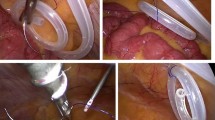Abstract
Purpose
Peritoneal dialysis (PD) is a commonly used method for renal support in pediatric patients and can be associated with the risk of post-surgical complications. We evaluated method of placement of PD catheters with regard to post-surgical complications.
Methods
PD catheters placed at two institutions between 2005 and 2017 were reviewed. Complication rates were evaluated based on method of placement, delayed usage, omentectomy, and patient age using Fisher’s exact test, two-sided, with significance set at 0.05. Factors influencing complication were evaluated with multivariate logistic regression and Kaplan–Meier survival analysis.
Results
There were 130 patients with 157 catheters placed, ranging in age from 1 day to 23 years. There was no significant difference in complication rate by method of placement or delayed usage. Infants were significantly more likely to experience leakage (21% vs 8%, p 0.036) and hernias (15% vs 5%, p 0.030). Patients that underwent an omentectomy were less likely to require a catheter replacement (7% vs 27%, p 0.004), and the catheters had a significantly higher survival rate (p 0.009). We found that laparoscopic intervention resulted in catheter salvage. Lateral exit sites may be a risk factor for catheter migration in some patients.
Conclusions
Omentectomy is associated with longer PD catheter survival. Laparoscopic salvage of dysfunctional catheters may be a valuable adjunct in management.

Similar content being viewed by others
References
Washburn KK, Currier H, Salter KJ, Brandt ML (2004) Surgical technique for peritoneal dialysis catheter placement in the pediatric patient: a North American Survey. Adv Perit Dial 20:218–221
Ustyol L, Peker E, Demir N, Agengin K, Tuncer O (2016) The use of acute peritoneal dialysis in critically Ill newborns. Med Sci Monit 22:1421–1426. https://doi.org/10.12659/MSM.898271
Mattioli G, Castagnetti M, Verrina E, Trivelli A, Torre M, Jasonni V et al (2007) Laparoscopic-assisted peritoneal dialysis catheter implantation in pediatric patients. Pediatr Urol 69:1185–1189. https://doi.org/10.1016/j.urology.2006.12.033
Lane JC, Warady BA, Feneberg R, Majkowski NL, Watson AR, Fischbach M et al (2010) Relapsing peritonitis in children who undergo chronic peritoneal dialysis: a prospective study of the international pediatric peritonitis registry. Clin J Am Soc Nephrol 5:1041–1046. https://doi.org/10.2215/CJN.05150709
Yavascan O, Anil M, Kara OD, Bal A, Akcan N, Senturk S (2011) The Comparison of exit-site care with normal saline and povidone–iodine in preventing exit-site infection and peritonitis in children on chronic peritoneal dialysis treatment. Saudi J Kidney Dis Transpl 22:931–934
Bakkaloglu S (2009) Prevention of peritonitis in children: emerging concepts. Perit Dial Int 29:S186–S189
Carpenter JL, Fallon SC, Swartz SJ, Minifee PK, Cass DL, Nuchtern JG et al (2016) Outcomes after peritoneal dialysis catheter placement. J Pediatr Surg 51:730–733. https://doi.org/10.1016/j.jpedsurg.2016.02.011
Cribbs RK, Greenbaum LA, Heiss KF (2010) Risk factors for early peritoneal dialysis catheter failure in children. J Pediatr Surg 45:585–589. https://doi.org/10.1016/j.jpedsurg.2009.06.019
Macchini F, Valade ÆA (2006) Chronic peritoneal dialysis in children: catheter related complications. A single centre experience. Pediatr S 22:524–528. https://doi.org/10.1007/s00383-006-1685-9
Ladd AP, Breckler FD, Novotny NM (2011) Impact of primary omentectomy on longevity of peritoneal dialysis catheters in children. AJS 201:401–405. https://doi.org/10.1016/j.amjsurg.2010.08.022
Phan J, Stanford S, Zaritsky JJ, Deugarte DA (2013) Risk factors for morbidity and mortality in pediatric patients with peritoneal dialysis catheters. J Pediatr Surg 48:197–202. https://doi.org/10.1016/j.jpedsurg.2012.10.035
Numanoglu A, Rasche L, Roth MA, McCulloch MI, Rode H (2008) Laparoscopic insertion with tip suturing, omentectomy, and ovariopexy improves lifespan of peritoneal dialysis catheters in children. J Laparoendosc Adv Surg Tech 18:302–305. https://doi.org/10.1089/lap.2007.0100
Radtke J, Schild R, Reismann M, Ridwelski R, Kempf C, Nashan B et al (2017) Obstruction of peritoneal dialysis catheter is associated with catheter type and independent of omentectomy: a comparative data analysis from a transplant surgical and a pediatric surgical department. J Pediatr Surg. https://doi.org/10.1016/j.jpedsurg.2017.06.028
White CT, Gowrishankar M, Feber J, Yiu V, Association C (2006) Clinical practice guidelines for pediatric peritoneal dialysis. Pediatr Nephrol 21:1059–1066. https://doi.org/10.1007/s00467-006-0099-1
Warady BA, Bakkaloglu S, Newland J, Cantwell M, Verrina E, Neu A et al (2012) Consensus guidelines for the prevention and treatment of catheter-related infections and peritonitis in pediatric patients receiving peritoneal dialysis: 2012 update. Perit Dial Int 32:S32–S86. https://doi.org/10.3747/pdi.2011.00091
Rahim KA, Seidel K, Mcdonald RA (2004) Risk factors for catheter-related complications in pediatric peritoneal dialysis. Pediatr Nephrol 19:1021–1028. https://doi.org/10.1007/s00467-004-1520-2
Beanes SR, Kling KM, Fonkalsrud EW, Torres M, Salusky IB, Quinones-baldrich WJ et al (2000) Surgical aspects of dialysis in newborns and infants weighing less than 10 kg. J Pediatr Surg 35:1543–1548. https://doi.org/10.1053/jpsu.2000.18303
Funding
None.
Author information
Authors and Affiliations
Corresponding author
Ethics declarations
Conflict of interest
MB LaPlant declares that she has no conflict of interest. DA Saltzman declares that he has no conflict of interest. BJ Segura declares that he has no conflict of interest. RD Acton declares that he has no conflict of interest. B Feltis declares that he has no conflict of interest. DJ Hess declares that he has no conflict of interest.
Ethical approval
All procedures performed in studies involving human participants were in accordance with the ethical standards of the institutional and/or national research committee and with the 1964 Helsinki declaration and its later amendments or comparable ethical standards.
Informed consent
For this type of study formal consent is not required.
Rights and permissions
About this article
Cite this article
LaPlant, M.B., Saltzman, D.A., Segura, B.J. et al. Peritoneal dialysis catheter placement, outcomes and complications. Pediatr Surg Int 34, 1239–1244 (2018). https://doi.org/10.1007/s00383-018-4342-1
Accepted:
Published:
Issue Date:
DOI: https://doi.org/10.1007/s00383-018-4342-1




